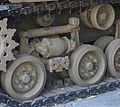Roller (tank)
In a chain-driven vehicle, such as a tank or construction machine, the roller is the part of the chain drive on which the vehicle stands. A chain drive in vehicles is impossible without the use of rollers.
history
In connection with the first chain-driven tractors designed by Holt, the roller was also developed. Running and support rollers ensure the tension of the chain between the guide and drive roller. The rollers are on the floor and are the only rollers that are spring-loaded. The suspension can be provided by torsion bar springs , leaf springs or also coil springs, the torsion bar suspension being the most widespread, particularly in vehicles used for military purposes. In all cases, the rollers move independently of one another and ensure high off-road mobility. Track rollers generally consist of two parts: an outer and an inner wheel. In the space between these two wheels, the chains are guided by teeth attached to their individual links so that the chain cannot jump off. The combination of rollers and support rollers keeps the chain under tension so that it is not thrown off.
Roller systems

Get Caterpillar
This system is no longer used by tanks today. It was one of the very first roller systems. The holt system consists of two rollers on a short axis, which is guided by a movable carrier. This is sprung by a torsion bar . Roller systems of this type can still be found in Caterpillar construction machines today .
Overlapping rollers (box drive)

The German engineers used various towing vehicles ( Sd.Kfz. 6 to Sd.Kfz. 11 ), the light and medium armored personnel carriers ( Sd.Kfz. 250 and Sd.Kfz. 251 ) and battle tanks ( Panther , Tiger and Tiger II ) Box drive . The rollers are offset on the outside and inside, which increases off-road mobility. The disadvantage of the design was the increased maintenance effort: to change a damaged inner roller, the two outer rollers (sometimes more) had to be removed first, which took a lot of time. Furthermore, the construction proved to be very problematic during the war against the Soviet Union , because at the low temperatures there, the snow or mud frozen between the rollers overnight blocked the rollers and made the vehicle unable to move.
Roller systems with roller carriages
Systems were also widely used that used rollers, so-called roller carriages, that were coupled by a spring mechanism. Typical representatives were the US-American M4 Sherman , which had two different systems that differed in the alignment of the spring deflection ( HVSS = Horizontal Volute Spring Suspension - horizontal conical suspension and VVSS = Vertical Volute Spring Suspension - vertical conical suspension), and the German Panzerkampfwagen IV .
Roller systems without support rollers
The T-34 is a prime example of this process. Its castors are designed in such a way that they also function as support rollers.
See also: Christie Drive
Individually suspended castors
In modern battle tanks, such as the Leopard 2 , the rollers are suspended individually with a torsion bar suspension. This system combines the cross-country mobility of the overlapping castors with the quick interchangeability of individually suspended rollers.
literature
- Philip Terwhit: tanks . Neuer Kaiserverlag, Klagenfurt 2005, ISBN 3-7043-3197-X .
- Roger Ford: tanks from 1916 to the present day . Karl Müller Verlag, Erlangen, ISBN 3-86070-676-4 .
- Fred Koch: Waffen-Arsenal Volume 172 - drives and chains of German battle tanks 1935-1945 , Podzun-Pallas-Verlag GmbH 1998, ISBN 3-7909-0629-8




